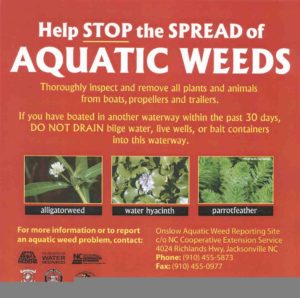Aquatic, Wetland, and Invasive Plants
go.ncsu.edu/readext?154943
en Español / em Português
El inglés es el idioma de control de esta página. En la medida en que haya algún conflicto entre la traducción al inglés y la traducción, el inglés prevalece.
Al hacer clic en el enlace de traducción se activa un servicio de traducción gratuito para convertir la página al español. Al igual que con cualquier traducción por Internet, la conversión no es sensible al contexto y puede que no traduzca el texto en su significado original. NC State Extension no garantiza la exactitud del texto traducido. Por favor, tenga en cuenta que algunas aplicaciones y/o servicios pueden no funcionar como se espera cuando se traducen.
Português
Inglês é o idioma de controle desta página. Na medida que haja algum conflito entre o texto original em Inglês e a tradução, o Inglês prevalece.
Ao clicar no link de tradução, um serviço gratuito de tradução será ativado para converter a página para o Português. Como em qualquer tradução pela internet, a conversão não é sensivel ao contexto e pode não ocorrer a tradução para o significado orginal. O serviço de Extensão da Carolina do Norte (NC State Extension) não garante a exatidão do texto traduzido. Por favor, observe que algumas funções ou serviços podem não funcionar como esperado após a tradução.
English
English is the controlling language of this page. To the extent there is any conflict between the English text and the translation, English controls.
Clicking on the translation link activates a free translation service to convert the page to Spanish. As with any Internet translation, the conversion is not context-sensitive and may not translate the text to its original meaning. NC State Extension does not guarantee the accuracy of the translated text. Please note that some applications and/or services may not function as expected when translated.
Collapse ▲ What IS that plant??
What IS that plant??
Have you ever seen a plant in a pond and thought “Gee, that looks nice. I think I’ll take a piece home with me!”
STOP!! Wait! That plant may be an invasive species or even on the Federal Noxious Weed list. Some of the plants are quite attractive; however, they can make Kudzu look like a slow grower. Give them an inch, and they will take over the entire pond, the neighbor’s pond, and then start on the local waterways.
What plants are these? Well, there are several very good websites with information about the various plants, plus how to identify them:
Federal Noxious Aquatic Weeds Poster
Not all aquatic plants are bad….but do you know the difference?
AQUATIC PLANT MANAGEMENT LINKS is a good site to find additional information about aquatic plant. The Aquatic & Shoreling Plant Selection publication by Clemson University is quite good; it discusses both invasive and beneficial plants.
Do you have too much of a good thing and want to know how to get rid of it…or at least control it better? The Aquatic Plant Management website has several useful guides. For example, Weed Management in Small Ponds lets you know the relative effectiveness of mechanical removal, biological control, and chemical control on a
particular plant.
There’s an app for that! NCSU has an aquatic plant identification app. You can download it to your device from the app store.
Mother Nature put to work
Several of these plants have a history of use in water treatment. Water hyacinth has been used to remove heavy metals from industrial wastewater. Cattails, Arrowhead, and other plants not mentioned here have been used in constructed wetlands for the treatment of landfill leachate, municipal waste, and agricultural waste. Eastern North Carolina is home to several wetland projects:
City of Goldsboro project
New Hanover County Landfill Constructed Wetlands project
Who named these things!?!
Alligatorweed, Coontail, Parrotfeather, Duckweed, Lizard’s tail, Duck potato… there’s even a Marsh Mallow!



